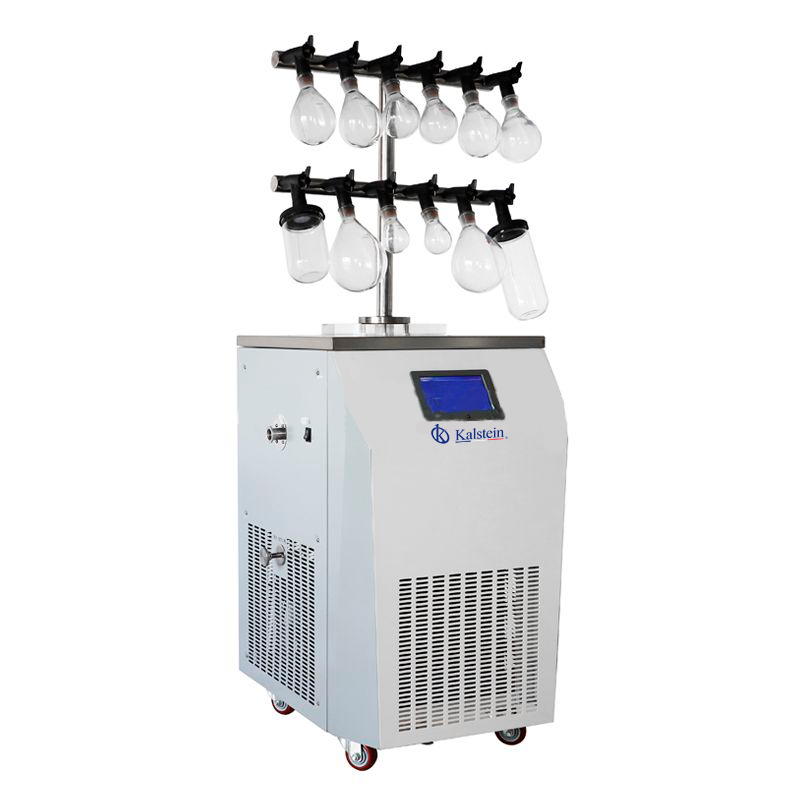It is a process of stabilization of a product, in which it is dried under vacuum by freezing it and removing the water present by sublimation and desorption, in such a way that there is no change in its basic structure or in its chemical composition, and the likelihood of reaction between its components and microbiological growth is minimized. This procedure is also called Freeze-drying and the finished product is characterized by being a solid, fragile network with high porosity, and soluble in water.
Freeze-drying is carried out at temperatures between 10 and 15 ºC below zero, within the stages of the process are:
- Initial Freezing: is a stochastic freezing phenomenon, the minimum temperature in case of crystalline solutions will be below eutectic temperature, or in case of amorphous solutions below the glass transition temperature. Nucleation and supercooling occur at this stage.
- Primary drying: This is where the sublimation process takes place, where most of the free water is steamed. This is worked under controlled pressure and there are different sources of heat transfer. The parameters temperature, pressure and time can be modified independently, but they are closely related.
- Secondary drying: in this last stage, the desorption of unfrozen water occurs, so that traces of water not bound to the product are removed.
The equipment used to develop this procedure is called a lyophilizer, and consists of:
- Dry chamber: this is where the freeze-dried substance is carried out. It can be made up of different compartments closed hermetically and under vacuum to perform sublimation.
- Condenser with cooling circuit: it is a device that communicates with the dry chamber and its function is to condense the steam that is produced in the sublimation. A coolant keeps it at a lower temperature than the dry chamber (-50 to -125 ºC).
- Vacuum system: it allows the removal of the air from the dry chamber when starting the freeze-drying process, with this system it is possible to reach the pressure conditions to extract the water product of sublimation.
Use of lyophilizers for storing vaccines
Vaccines are biological substances, which their correct conservation is necessary to avoid adverse events and ensure their effectiveness. These biopharmaceuticals should be lyophilized because they are usually unstable in solution. The freeze-drying technology favors the large-scale production of vaccines, this is because there are many bacteria and viruses that survive this freezing process. The main advantages offered by lyophilization in vaccine production are: protecting biological activity, ensuring sterility, extending shelf life and increasing the accuracy of doses.
Cold chain for vaccine preservation
These are all elements and activities (distribution, transport, handling, storage and storage in optimal light and temperature conditions) necessary to ensure the immunizing potency of vaccines. Vaccine production requires strict thermostabilization processes, yet its safety and efficacy also depend on the cold chain to reach the person to be vaccinated. Among the recommendations to maintain the potency of vaccines:
- Store lyophilized vaccine antigens and the saline diluent at a storage temperature between 2°C and 8°C (36°F and 46°F). In maintaining the appropriate temperature, consideration should be given to the characteristics of the vaccine, such as: equipment of personnel, types of refrigerators, transport, packaging and storage standards. The loss of vaccine potency is variable and depends on the achieved temperature thresholds and the exposure time.
- Do not freeze the vaccine. Deterioration caused by temperatures below 0 °C is irreversible as they cause product inactivation. Deterioration due to higher than established temperatures is cumulative.
- Protect from light because the vaccine may be made up of light-sensitive organisms.
- Do not use the lyophilized vaccine antigens and the saline diluent after the expiry date which is stated on the vial labels.
- Discard reconstituted vaccines if not used within 30 minutes.
At KALSTEIN we offer you freeze-drying equipment specifically designed to meet processes with high-level requirements, such as the development and production of vaccines. For PURCHASE, SALE, or PRICE information, contact us on our website: HERE



















